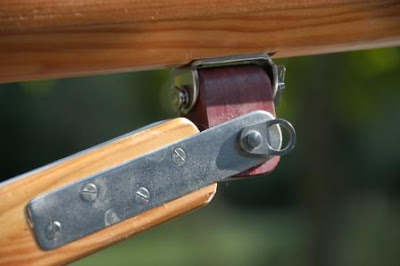August 2009 - and I've come to the end of the build blog. It remains to be seen if we start another blog to record the sailing adventures of Idle Fiddler and its crew.
However, I cannot let the opportunity pass without making sure that my 'build partner' Paul Lewis receives the recognition that is due to him. Yes, I wrote the blog, and consequently have received many kind comments on the quality of the build etc but virtually all of the items that evoked praise were down to Paul - they were his ideas and his craftsmanship.
We've greatly enjoyed the whole project and in all the 4 and half years we've never even had a cross word or disagreement. Thankfully too, we've had very understanding and supportive wives - so a big thanks to Anne and Sheila who have scraped, sanded, painted, shoved, lifted, listened, mopped brows, and provided endless tea , food and encouragement!
Friday, 7 August 2009
Modifications 2 - snotter to goosneck on the boom

The other major modification was to the sprit boom. We liked the idea of a loose footed sail, the idea of the boom being out of 'head-thwacking' range and the way in which the sprit could be used to help maintain the set of the sail. However, what we didn't like was the constant snagging of the jib sheets when tacking. So, more discussion on the best way forward! We didn't like the goosenecks on the market so we decided to make our own.
Paul, as usual, came up trumps with a design which he made himself using 25mm wide x 5mm thick stainless steel for the mast bracket and the boom straps. The 2 way pivoting 'knuckle' joint was made out of very hard purple heart. Again we used stainless dropnose pins to keep it all together.
A few modifications - the tabernacle





I mentioned previously that during the sailing trials it became apparent that we would have to do a few things to make life easier for pre-sail rigging and to correct what we felt was a tendency for the jib sheets to snag on the snotter arrangement every time we changed tack.
The first priority was to look at a tabernacle arrangement so that we could take away the 'struggle' (for us) of inserting the hollow wooden mast through the fore deck and into the step.
The advantages would be considerable by reducing the rigging time, take away the risk of a dangerous slip or fall whilst trying to locate the mast, and finally allowing us to use the mast when hinged down and at rest as a structural support to the boat cover.
Paul and I had lots of discussions on the best design and we did a lot of asking and web searches. We then produced a mock up to test the feasibility before taking the plunge and cutting the old round hollow wooden mast at a point above the foredeck. The old 'discarded' piece was replaced by two new solid pieces; the lower portion maintained the round section to go through the foredeck but had a rectangular section above the foredeck which fitted into the tabernace. The 'upper' section had the same rectangular section to fit the tabernacle but then tapered to fit the old round section of the mast. Paul made both of these new sections on his lathe. A few photographs are worth a thousand words!
Although we made most of the tabernacle ourselves we eventually took it to a local fabricator who welded a back plate on for us and polished it. The result was extremely pleasing and worked well using two 10mm x 80mm 316 stainless dropnose pins as pivot and locking devices. The design meant that all the compression forces were transferred to the keel via the mast and also via the tabernacle itself.
Subscribe to:
Posts (Atom)